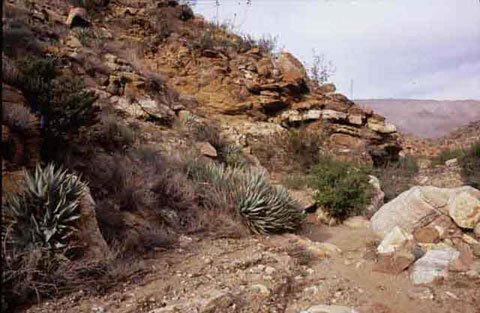Central Anza-Borrego: Plum Canyon

Plum Canyon
Back in the days when the roads across the desert were simple and unpaved,
the way to get from Yaqui Well to Earthquake Valley was through Plum Canyon.
Highway 78 did not exist. The roads over which people drove their wagons have
long since washed away, shrinking to peaceful hiking trails. There is nothing
here to attract today's speeding motorists, and that of course is a plus for
people who like it quiet.
Plum Canyon apparently was named for the Desert Apricot, Prunus fremontii,
a deciduous shrub which grows by the side of the road and produces deliciously
fragrant white flowers in spring, but for all too brief a time. You are more
likely to see the red flowers of the Chuparosa, Justicia californica, a plant
which sometimes grows to shrublike proportions in Plum Canyon and which
attracts hummingbirds..
Cactus, particularly Teddy-Bear Cactus, Cylindropuntia bigelovii,
grows in abundance on Sentenac Mountain. If you look up at the mountains to
the south, you can see Juniper and Yucca that are signs of the Pinyon-Juniper
Woodland, an area which holds the promise of good birding.
You can drive into Plum Canyon to a fork in the road. The left fork takes
you south toward the base of the mountains. The right fork takes you west
a point where you must park your car if you want to walk (on the California
Riding & Hiking Trail) out of the canyon to the top of the ridge for a
view of Earthquake Valley. The California Riding & Hiking Trail continues
south to Blair Valley, Box Canyon, and beyond.
Getting to Plum Canyon. The entrance to Plum Canyon is on
the south side of Highway 78 in the San Felipe Valley just east of Sentenac
Mountain and the entrance to Sentenac Canyon. From Borrego Springs, take County
Road S-3 south to Highway 78 and turn west, or from the southern desert take
County Road S-2 north to Highway 78 and turn east.
|